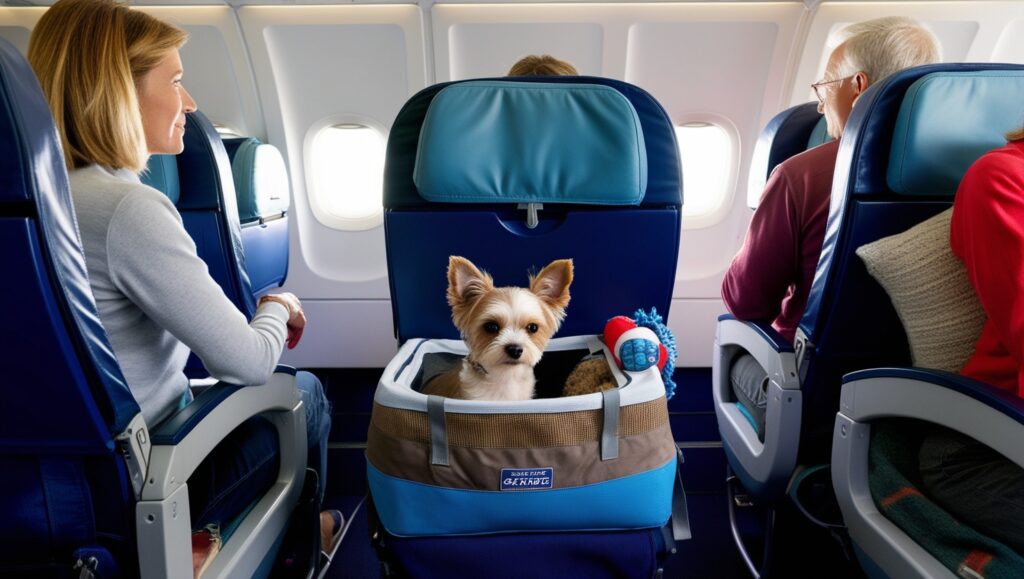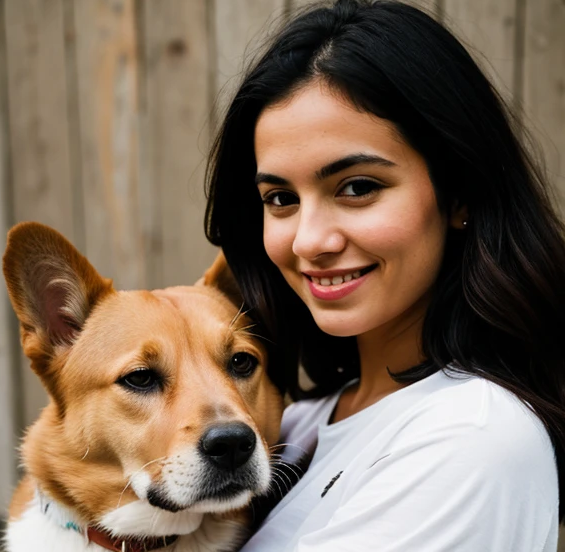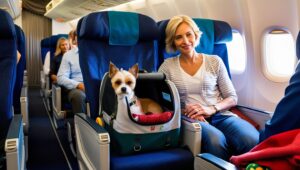
All tag An airline passenger seated in an airplane, with a small dog in an airline-approved carrier placed under the seat in front of them.
Introduction
Picture this: You’re boarding a plane with your furry best friend, excited but also a bit anxious about the upcoming flight. As you settle into your seat, your dog looks up at you with those trusting eyes, and the question pops into your head—Can I hold my dog during takeoff?
While it might seem comforting to keep your pet close in such a high-pressure situation, the reality is that safety regulations are clear on this matter. In this post, we’ll dive into why holding your dog during takeoff isn’t allowed, the airline policies designed to protect both pets and passengers, and how you can ensure your dog is safe and comfortable throughout the journey.
Safety Regulations for Pets During Takeoff
Airlines have strict safety protocols in place when it comes to pets traveling in the cabin. According to aviation safety guidelines, all pets must be secured in an approved carrier or harness during takeoff, landing, and times of turbulence. These rules aren’t just about following regulations—they’re designed to protect everyone on board.
Securing pets ensures that in the event of sudden movements, turbulence, or emergencies, your dog won’t be at risk of injury. A loose pet can become a safety hazard, both for themselves and for other passengers. By following these regulations, airlines aim to minimize the risk of accidents and ensure a smooth, safe flight for all.
3. Airline Policies on Holding Pets
When it comes to flying with pets, most airlines have specific policies that prioritize safety and consistency. For dogs traveling in the cabin, the general rule is that they must remain in a carrier under the seat in front of you for the duration of the flight. This includes takeoff, landing, and any periods of turbulence. The reasoning behind this policy is rooted in safety—keeping your pet in a secure space reduces the risk of injury or disruption during sudden movements or in-flight emergencies.
Although it might be tempting to hold your dog in your arms or on your lap, especially during takeoff when the noise and movement can be unsettling for pets, doing so is generally not allowed. Holding a pet in the cabin can pose significant risks if turbulence occurs, potentially leading to injury to both the animal and passengers. Additionally, a loose pet could become a distraction or hazard to flight attendants and fellow travelers.
4. The Role of Carriers and Harnesses
Pet carriers play a crucial role in ensuring your dog’s safety during a flight. These carriers are designed to fit snugly under the seat in front of you, keeping your dog secure and minimizing movement during the flight’s most critical moments, such as takeoff and landing. A well-ventilated, airline-approved carrier also helps reduce anxiety for pets by providing a familiar, enclosed environment.
For service dogs and some emotional support animals, certain airlines allow the use of special travel harnesses. These harnesses attach securely to the seatbelt, ensuring that larger dogs remain restrained while still being able to stay close to their owner. It’s important to check with your specific airline to confirm whether they allow the use of such harnesses and if your dog qualifies for this option. Regardless of the method, the goal is the same: keeping your pet safe and secure throughout the flight.
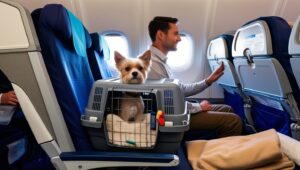
All Tag An airline passenger seated in an airplane, with a small dog in an airline-approved carrier placed under the seat in front of them.
5. Risks of Holding Your Dog During Takeoff
Holding your dog during takeoff might seem like a comforting idea, but it presents serious risks. Turbulence or sudden movements during takeoff can occur without warning, and a pet held in your arms or lap can easily be thrown from your grip, leading to injury. In severe cases, both you and your dog could be hurt if turbulence causes you to lose balance or collide with the seat in front of you. Additionally, a loose pet could become a distraction or obstruction for flight attendants, potentially delaying responses in an emergency situation.
Failing to follow safety regulations can also create unnecessary chaos on board. For example, a frightened dog could dart into the aisle, causing a tripping hazard for passengers or crew members. In some situations, not securing your pet properly can result in fines or being denied future pet travel privileges by the airline.
6. Alternatives to Holding Your Dog
There are safer and more effective ways to keep your dog calm during takeoff without holding them. Start by familiarizing your dog with their carrier well in advance of the flight. Let them explore and rest inside it at home so it feels like a safe space. On the day of travel, placing a favorite blanket or toy inside the carrier can provide comfort and reduce anxiety.
You may also consider using calming aids, such as veterinarian-approved calming treats, pher
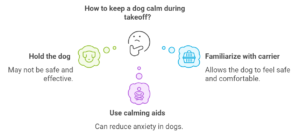
7. Conclusion
While it’s understandable to want to hold your dog during takeoff, the rules and safety protocols are in place for good reason. By ensuring your dog is secured in an airline-approved carrier or harness, you’re protecting them from potential harm caused by turbulence or sudden movements. Though you can’t physically hold your dog, there are plenty of ways to help them feel safe and comfortable during the flight.
Before you travel, always check the specific policies of your airline to make sure you’re prepared. Each airline may have slightly different guidelines, especially when it comes to larger service animals or alternative restraints.
Have you flown with your pet before? Share your experiences or ask any questions you might have in the comments! We’d love to hear your tips for making air travel smooth and safe for your furry companions.
FAQ
1. Can I take my dog out of the carrier once the plane is in the air?
No, most airlines require that pets remain in their carriers under the seat for the entire duration of the flight, including takeoff, landing, and periods of turbulence. Always check with your specific airline for their rules.
2. Are there any exceptions for service animals?
Yes, service animals are generally allowed to sit with their owners outside of a carrier, but they must be secured with a special travel harness attached to the seatbelt. Different airlines may have specific requirements, so verify before traveling.
3. What kind of carrier should I use for my dog?
You should use an airline-approved pet carrier that is well-ventilated and fits under the seat in front of you. It should be large enough for your dog to stand, turn around, and lie down comfortably, but still meet the airline’s size restrictions.
4. Can I give my dog something to help them stay calm during the flight?
Yes, many pet owners use veterinarian-approved calming aids like anxiety wraps, calming treats, or pheromone sprays to keep their dogs relaxed. Always consult your vet before administering any calming aids.
5. What should I do if my dog becomes anxious during the flight?
Try to calm your dog by speaking in a soothing voice, providing a favorite toy, or using a blanket with a familiar scent. Ensure the carrier is positioned securely under the seat so your dog feels safe, and avoid taking them out of the carrier.

